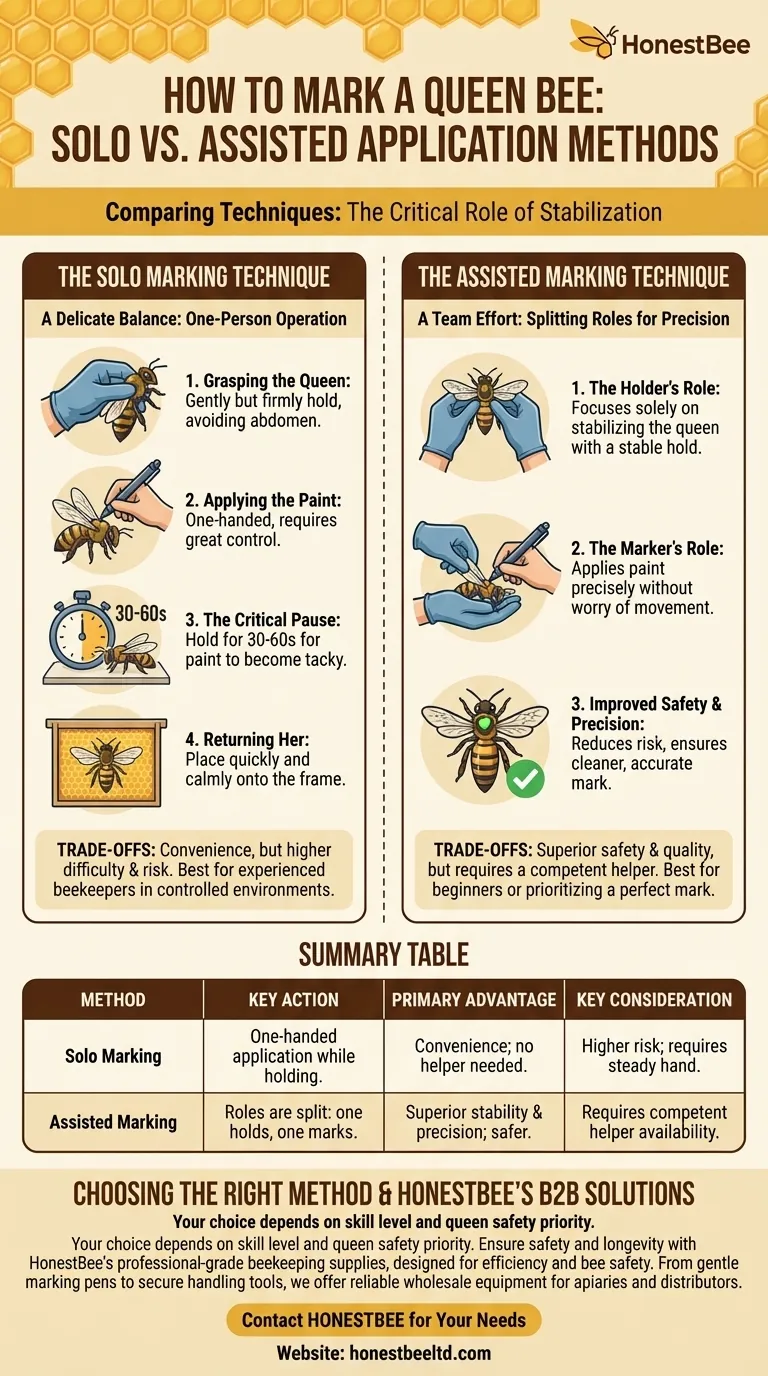The primary difference lies in how the queen is stabilized during the marking process. When working alone, a beekeeper must simultaneously hold the queen and apply the paint, a delicate one-handed operation. With a helper, the roles are split, allowing one person to focus entirely on securing the queen while the other applies the paint with greater precision and control.
While both methods accomplish the task, having a helper transforms the procedure from a test of dexterity into a stable, two-person operation. The helper's primary role is to provide superior stabilization, freeing the marker to focus exclusively on a clean and safe paint application.

The Solo Marking Technique: A Delicate Balance
When you work alone, you are responsible for every step of the process. This requires confidence and a steady hand.
Grasping the Queen
Your first task is to gently but firmly hold the queen. This is typically done by picking her up by the wings or thorax, avoiding any pressure on her fragile abdomen.
Applying the Paint
With the queen held securely in one hand, you use your other hand to apply a small daub of paint to the center of her thorax. This is the hardest part of the solo method, as it requires great control.
The Critical Pause
After applying the paint, you must continue to hold her gently for 30 to 60 seconds. This brief period allows the paint to become tacky and begin to dry, preventing it from smearing when she moves through the hive.
Returning Her to the Frame
Once the paint is partially set, you can carefully place her back onto the frame among the other bees. The goal is to make the entire process as quick and calm as possible to minimize stress.
The Assisted Marking Technique: A Team Effort
Introducing a helper fundamentally changes the dynamic, making the process safer for the queen and easier for the beekeeper.
The Holder's Role
One person is designated as the "holder." Their only job is to secure the queen. As the reference material notes, this often involves using a thumb to trap some of her legs, providing a much more stable hold than the solo method allows.
The Marker's Role
The second person, the "marker," can now focus entirely on applying the paint. With the queen held steady by their partner, they can apply a perfect, small dot to the center of the thorax without having to worry about the queen moving.
Improved Safety and Precision
This division of labor dramatically reduces the risk of accidentally dropping or injuring the queen. It also almost always results in a cleaner, more accurately placed mark.
Understanding the Trade-offs
Neither method is inherently superior; the best choice depends on your situation, experience, and confidence.
The Solo Method
The primary advantage is convenience—you can mark a queen whenever you find her without needing to coordinate with another person. The disadvantage is the higher degree of difficulty and the increased risk to the queen, especially for less experienced beekeepers.
The Assisted Method
The key advantage is safety and quality. It is far less stressful for a beginner and provides a much more stable platform for applying the paint. The only real disadvantage is the need to have a competent helper available.
Choosing the Right Method for You
Your choice should be guided by a clear assessment of your skill level and the priority you place on the queen's safety.
- If you are new to beekeeping or marking queens: Always work with a helper to minimize risk and build your confidence.
- If you are an experienced beekeeper working alone: Ensure you are in a calm, controlled environment and use a gentle, practiced touch.
- If your primary focus is a perfect, long-lasting mark: The assisted method is superior, as the stability it provides allows for ideal paint application.
Ultimately, the best method is the one that ensures the queen's safety while providing you with a clear, lasting mark.
Summary Table:
| Method | Key Action | Primary Advantage | Key Consideration |
|---|---|---|---|
| Solo Marking | One-handed paint application while holding the queen. | Convenience; no helper needed. | Higher risk of injury; requires a steady hand. |
| Assisted Marking | Roles are split: one holds, one marks. | Superior stability and precision; safer for the queen. | Requires a competent helper to be available. |
Ensure the safety and longevity of your queens with the right marking tools. Whether you're a commercial apiary or a beekeeping equipment distributor, HONESTBEE supplies high-quality, professional-grade beekeeping supplies designed for efficiency and bee safety. From gentle marking pens to secure handling tools, our wholesale-focused operations provide the reliable equipment you need. Contact HONESTBEE today to discuss your specific needs and elevate your beekeeping operations.
Visual Guide

Related Products
- Queen Bee Marking Pen UNI Medium Point for Queen and Bee Marking
- Queen Bee Marking Pen POSCA Queen Marking Pens for Beekeeping Bee Markers
- Plastic Queen Marking Tube Cage with Plunger for Beekeeping
- Professional Engraved Round Hive Number Tags for Beekeeping
- Plastic Chinese Queen Grafting Tool for Bee Queen Rearing
People Also Ask
- How should a Posca pen be prepared for queen marking? Ensure a Safe, Precise Mark Every Time
- What are the benefits of marking queen bees? Boost Hive Health & Management Efficiency
- What is the process for priming a paint pen before marking a Queen bee? Ensure a Safe, Quick Marking Procedure
- What are the characteristics of Posca pens for marking queens? A Safe, Durable Solution for Hive Management
- What is the purpose of a queen marking pen in beekeeping? Essential for Efficient Hive Management



















